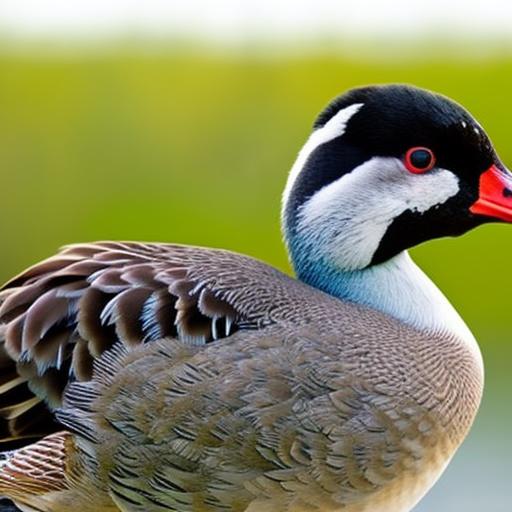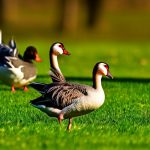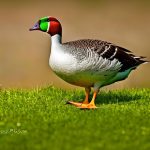Canadian geese, also known as Canada geese, are large waterfowl that are native to North America. They are known for their distinctive black heads, white cheeks, and long necks. These geese are highly adaptable and can be found in a variety of habitats, including lakes, rivers, wetlands, and grassy fields. They are migratory birds, with some populations traveling thousands of miles each year to breed and winter in different areas.
The habitat of Canadian geese is crucial for their survival. They rely on these habitats for nesting, feeding, and resting. Wetlands provide them with abundant food sources such as aquatic plants and insects, while grassy fields offer grazing opportunities. Protecting the habitat of Canadian geese is essential to ensure their population remains healthy and sustainable.
Key Takeaways
- Canadian Geese are a common sight in North America and are known for their distinctive honking calls and V-shaped flying formations.
- Laws and regulations are in place to protect Canadian Geese and their habitats, both at the federal and state levels.
- Feeding Canadian Geese is generally prohibited, and violators may face penalties such as fines or even imprisonment.
- There are exceptions to feeding laws, such as during migration season or for scientific research purposes.
- To prevent Canadian Geese from becoming a nuisance, it is important to avoid feeding them, keep a safe distance, and dispose of trash properly.
Understanding the Importance of Laws to Protect Canadian Geese
Laws are necessary to protect Canadian geese because they help regulate human activities that may harm or disrupt their habitat. These laws aim to prevent the destruction of wetlands, pollution of water sources, and disturbance of nesting sites. By enforcing these laws, authorities can ensure that human activities do not negatively impact the survival and well-being of Canadian geese.
It is important for individuals to follow these laws to protect Canadian geese because their actions can have significant consequences on the population and habitat of these birds. By respecting laws that prohibit hunting or disturbing nesting sites, individuals can help maintain a healthy population of Canadian geese and preserve their natural habitats for future generations.
Overview of Federal Laws and Regulations for Canadian Geese
At the federal level, there are several laws and regulations in place to protect Canadian geese. One of the most important laws is the Migratory Bird Treaty Act (MBTA), which was enacted in 1918. This act makes it illegal to hunt, capture, kill, or disturb migratory birds, including Canadian geese, without a proper permit. The MBTA also prohibits the possession, sale, or transport of migratory bird parts, such as feathers or eggs.
In addition to the MBTA, the U.S. Fish and Wildlife Service (USFWS) has established regulations for hunting Canadian geese. These regulations set limits on the number of geese that can be harvested during hunting seasons and specify the methods and equipment that can be used. These regulations help ensure that hunting activities are sustainable and do not harm the overall population of Canadian geese.
State-Level Laws and Regulations for Canadian Geese
In addition to federal laws, individual states have their own laws and regulations for protecting Canadian geese. These laws may vary from state to state, but they generally align with federal regulations and aim to provide additional protection for these birds.
For example, many states have established hunting seasons and bag limits for Canadian geese that are more restrictive than federal regulations. This allows states to tailor their hunting regulations to the specific needs and population levels of Canadian geese within their borders.
States also have laws and regulations in place to protect nesting sites and prohibit the disturbance of nesting geese. These laws may include restrictions on activities such as mowing grassy areas during nesting season or approaching nesting sites too closely.
Prohibitions on Feeding Canadian Geese: What You Need to Know
Feeding Canadian geese is generally prohibited in many areas due to the negative impacts it can have on both the geese and their habitat. When people feed geese, it can lead to an overpopulation of these birds in certain areas, which can result in habitat degradation and increased competition for resources.
Feeding Canadian geese can also lead to health issues for the birds. Human food is not suitable for their diet and can cause malnutrition or digestive problems. Additionally, when geese become dependent on human handouts, they may lose their natural foraging instincts and become less able to find food on their own.
Penalties for Violating Canadian Geese Feeding Laws

The penalties for violating Canadian geese feeding laws can vary depending on the jurisdiction and the severity of the offense. In some areas, feeding geese may result in a warning or a fine. Repeat offenders or those who engage in more serious violations, such as intentionally harming or killing geese, may face more severe penalties, including imprisonment.
It is important to note that penalties for violating Canadian geese feeding laws are in place to deter individuals from engaging in activities that can harm the birds and their habitat. By enforcing these penalties, authorities can send a clear message that feeding geese is not only harmful but also illegal.
Exceptions to Canadian Geese Feeding Laws: When Feeding is Allowed
While feeding Canadian geese is generally prohibited, there are some exceptions to this rule. In certain cases, feeding may be allowed for specific purposes, such as wildlife rehabilitation or scientific research. However, these exceptions are typically granted on a case-by-case basis and require proper permits or authorization.
It is important to consult local regulations and authorities to determine if there are any exceptions to feeding laws in your area. If you believe there is a legitimate reason to feed Canadian geese, it is crucial to obtain the necessary permits and follow any guidelines or restrictions that may be in place.
Tips for Preventing Canadian Geese from Becoming a Nuisance
Preventing Canadian geese from becoming a nuisance can help maintain a healthy balance between these birds and human activities. Here are some tips for preventing geese from becoming a nuisance:
1. Maintain natural barriers: Planting dense vegetation or installing fences around water bodies can discourage geese from nesting or congregating in certain areas.
2. Use deterrents: Visual deterrents, such as scarecrows or reflective tape, can help deter geese from settling in unwanted areas. Noise deterrents, such as loud noises or predator calls, can also be effective.
3. Modify habitat: Altering the habitat to make it less attractive to geese can help prevent them from becoming a nuisance. This can include removing or reducing food sources, such as mowed grass or spilled grain.
4. Educate the public: Raising awareness about the negative impacts of feeding geese and the importance of responsible behavior can help prevent geese from becoming a nuisance. Providing information and resources to the public can encourage them to take appropriate actions.
Public Education and Awareness: Promoting Responsible Behavior Around Canadian Geese
Public education and awareness are crucial for promoting responsible behavior around Canadian geese. By educating the public about the importance of protecting these birds and their habitat, individuals can make informed decisions and take appropriate actions to minimize their impact on geese populations.
Public education efforts can include distributing informational materials, organizing workshops or seminars, and partnering with local schools or community organizations to raise awareness about Canadian geese and their conservation needs. These efforts can help foster a sense of stewardship and encourage individuals to take responsibility for their actions.
The Importance of Protecting Canadian Geese for Future Generations
In conclusion, protecting Canadian geese and their habitat is crucial for maintaining healthy populations of these birds and preserving their natural environment for future generations. Laws and regulations at both the federal and state levels play a vital role in ensuring the protection of Canadian geese.
By following these laws and regulations, individuals can contribute to the conservation efforts for Canadian geese and help maintain a balance between human activities and the needs of these birds. Additionally, public education and awareness are essential for promoting responsible behavior around Canadian geese and fostering a sense of stewardship among the public.
It is up to each individual to take action and make a difference in the protection of Canadian geese. By respecting laws, preventing geese from becoming a nuisance, and promoting responsible behavior, we can ensure that these magnificent birds continue to thrive for generations to come.
If you’re interested in learning more about laws that exist to keep people from feeding Canadian geese, you might also find this article on poultrywizard.com helpful. It provides valuable information on various aspects of keeping chickens, such as building a chicken coop with a nest box (source), renting a chicken coop (source), and even installing a heater in a chicken coop (source). While it may not directly address the topic of Canadian geese, it offers valuable insights into the world of poultry keeping.
FAQs
What are Canadian geese?
Canadian geese are a species of waterfowl that are native to North America. They are known for their distinctive black heads and necks, white cheeks, and brown bodies.
Why do people feed Canadian geese?
People often feed Canadian geese because they enjoy watching them and want to interact with them. However, feeding them can have negative consequences for both the geese and the environment.
What laws exist to keep people from feeding Canadian geese?
There are no specific laws that prohibit people from feeding Canadian geese. However, many parks and wildlife areas have regulations that prohibit feeding wildlife in general, including geese.
Why is feeding Canadian geese harmful?
Feeding Canadian geese can cause them to become dependent on human-provided food, which can lead to health problems and a disruption of their natural feeding patterns. It can also cause them to congregate in large numbers, which can lead to overgrazing and damage to the environment.
What are some alternatives to feeding Canadian geese?
Instead of feeding Canadian geese, people can enjoy watching them from a distance and appreciate their natural behaviors. They can also support conservation efforts and habitat restoration projects that help to protect and preserve the natural habitats of Canadian geese and other wildlife.
Meet Walter, the feathered-friend fanatic of Florida! Nestled in the sunshine state, Walter struts through life with his feathered companions, clucking his way to happiness. With a coop that’s fancier than a five-star hotel, he’s the Don Juan of the chicken world. When he’s not teaching his hens to do the cha-cha, you’ll find him in a heated debate with his prized rooster, Sir Clucks-a-Lot. Walter’s poultry passion is no yolk; he’s the sunny-side-up guy you never knew you needed in your flock of friends!







